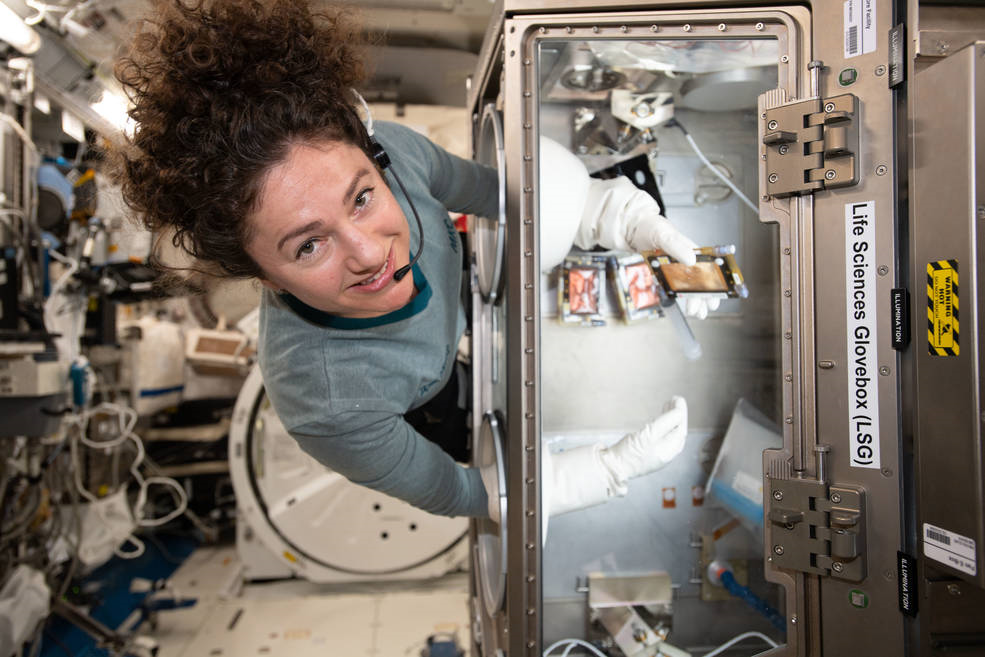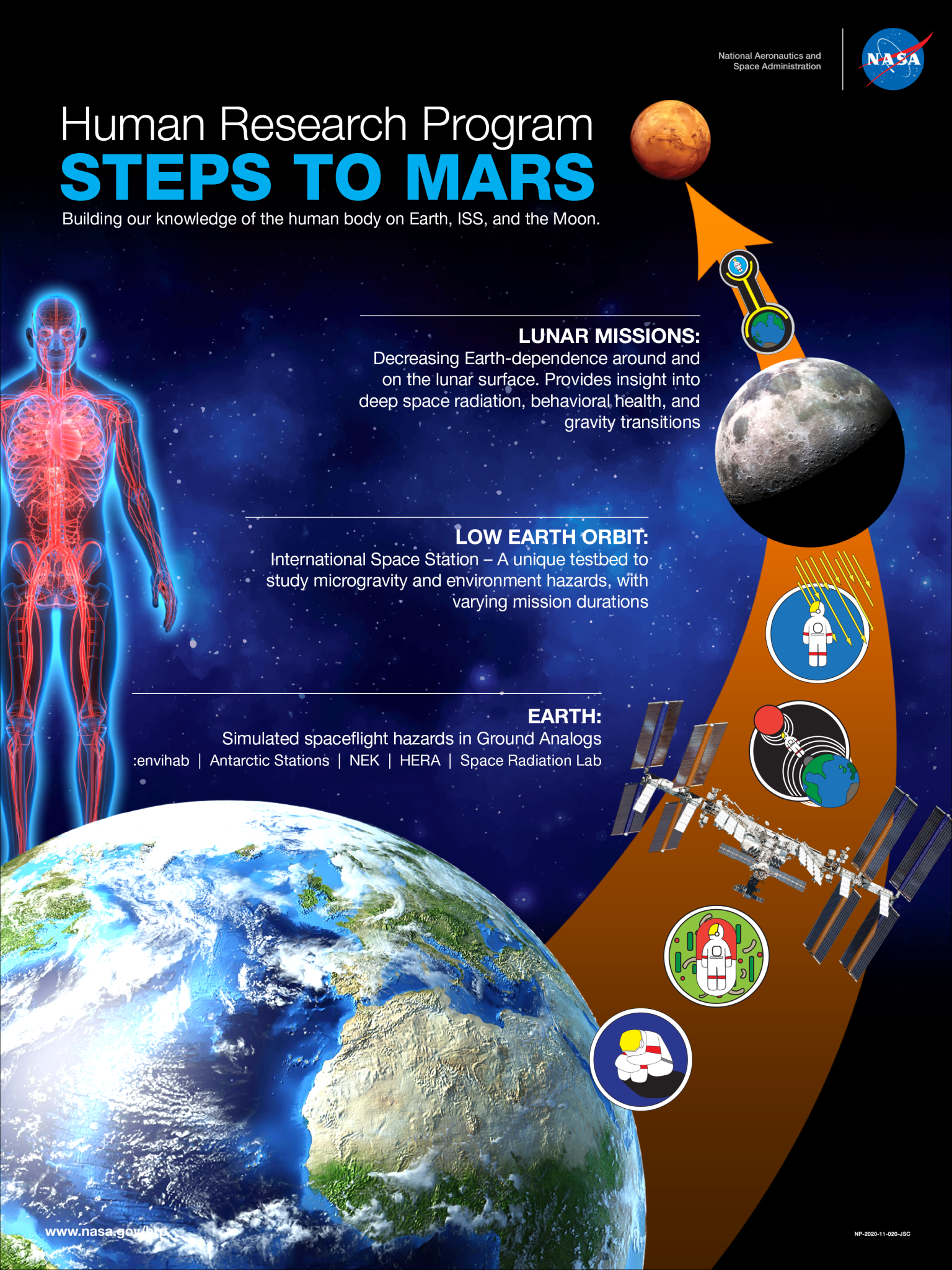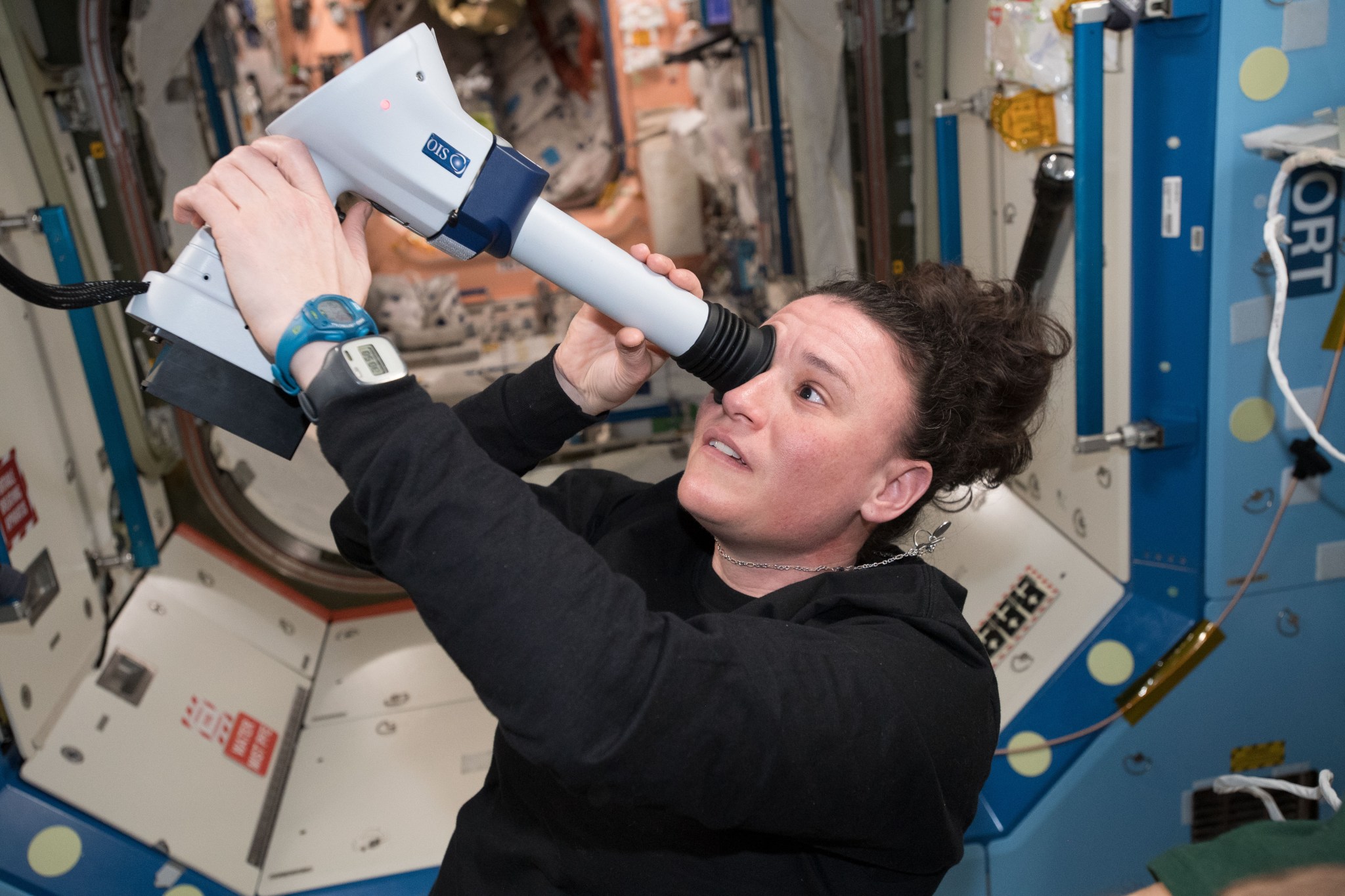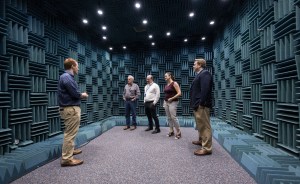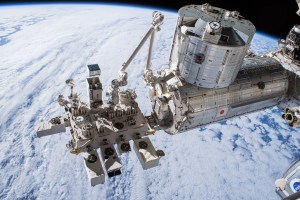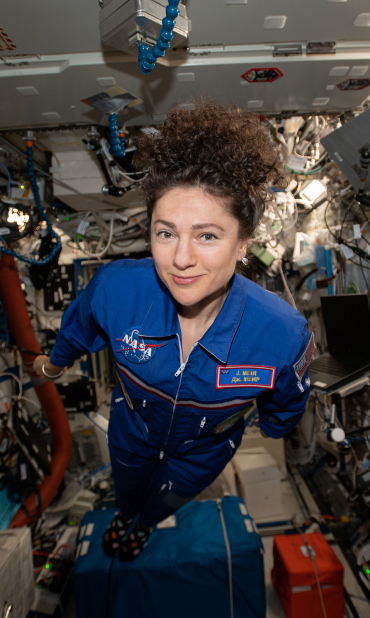This article is part of a series that details each step NASA’s Human Research Program is taking to prepare humans for long-duration missions to space. Step 1 involves Earth-bound simulations of life in space. Step 2, described below, relies on research conducted on the International Space Station to better understand and manage the effects of long-duration missions. Step 3 tackles the challenge of keeping humans healthy in the deeper space environment of the Moon. For an overview of these steps, click here.
NASA is preparing for human missions to Mars with a steppingstone approach to expanding our presence farther into the solar system. The agency will take the knowledge gained on Earth, build on research and experience aboard the International Space Station, and learn to live and work on the Moon under the Artemis program in preparation for missions to the Red Planet.
Aboard the space station, which orbits about 250 miles above Earth at 17,500 miles per hour, NASA’s Human Research Program team conducts research to help understand and manage the effects of extended stays in space. In addition to research using analogs on Earth and, one day, the Gateway in lunar orbit, researchers can find ways to reduce risks and maintain the health and well-being of crew members during and after their missions.
“The space station provides a unique scientific platform where we can further understand the risks associated with spaceflight,” said Scott Wood, research operations and integration element scientist at NASA. “We are routinely improving our understanding of the risks of spaceflight, as well as implementing countermeasures to keep astronauts healthy and productive.”
These risks are grouped under the five hazards of human spaceflight: radiation; isolation and confinement; distance from Earth; changes in gravity; and hostile and closed environments. Radiation exposure increases the risk of cancer in astronauts. Isolation aboard spacecraft and inside habitats increases their risk for behaviors that could affect performance and mission success. Their distance from Earth imposes a need for more crew autonomy. Variations in gravity sometimes cause adverse physiological adaptations in people. Finally, hostile and closed environments may affect immunity in crews.
A Harsh Environment
The microgravity environment on the space station affects the human body in a variety of ways. Prolonged exposure to microgravity without countermeasures to reduce its effects can cause the heart to lose muscle mass, and bones and muscles to atrophy.
“Microgravity is the hazard we’ve studied the most,” said Steven Platts, deputy chief scientist of NASA’s Human Research Program. “Although some aspects of microgravity can be simulated on the ground, the space station enables research that would not be possible on Earth.”
Buoyancy pools, such as NASA’s Neutral Buoyancy Laboratory, and parabolic flights aboard airplanes can simulate the feeling of weightlessness for crews. However, it can be difficult to gather data about the long-term effects of microgravity and identify effective ways to prevent or reduce those effects.
Researchers are investigating the effects of microgravity on many systems in the body. They are tracking how the heart and arteries respond to blood pressure changes caused by spaceflight, optimizing exercise prescriptions for each astronaut, and evaluating how factors from nutrition to carbon dioxide levels on the space station play a role in daily life in space. With this research, NASA is developing countermeasures to ensure physiological health, which will be essential for longer missions to the Moon and Mars.
Bone Mass Matters
On average, bones that bear most of the weight of astronauts on Earth lose approximately 1% to 2% of bone mass each month in space without the appropriate countermeasures. NASA has tracked how bones change on long-duration missions for many years and has developed exercise and nutrition countermeasures to help reduce the total loss in bone. However, uncertainty remains about how bones change during longer-duration missions as the body adapts in space.
To respond to this concern, NASA is using high-resolution, 3D bone imaging on astronauts before and after a year-long stay on the space station. With this insight, NASA hopes to determine the extent to which the microscopic structure of bones change on longer space voyages in preparation for a three-year round-trip journey to Mars and back to Earth.
Altered Immune System
The immune system, which helps protect the body from outside intruders such as bacteria and viruses, changes during spaceflight.
Altered immunity can increase the risk of various illnesses, including the cold or flu. Astronauts will need strong immune systems to pursue interplanetary space travel and ensure a safe and successful journey.
NASA is analyzing blood and saliva samples that astronauts have taken while in space to detect changes in their immune system, and comparing the data against self-reported health information. The research provides a way to shed light on subtle changes in the immune system that may occur before symptoms appear. This could inform treatment options that prevent a disease or infection from worsening. The data also could help scientists better understand the influence that the spaceflight environment has on the immune system, and reveal potential health risks on future missions to Mars and how those risks might be prevented.
The Great Unknown
The most difficult risks for which to prepare are those that are unknown. A prime example is a condition that researchers do not yet fully understand, in which potential structural changes in the eye and brain produce vision impairment, called Spaceflight Associated Neuro-ocular Syndrome, or SANS.
Scientists suspect the fluid shifts in microgravity upward to the head may be the culprit behind SANS. Researchers are measuring how fluids in the body shift from the lower to the upper body of astronauts aboard the space station, potentially increasing intracranial pressure and vision impairment. By studying the relationship between fluid shifts and vision impairment of astronauts, scientists hope to identify the cause of the syndrome and develop countermeasures for prolonged spaceflight.
Survive and Thrive
The Human Research Program is working to ensure astronauts thrive – not merely survive – on trips to the Moon and Mars. The risks crews face during interplanetary space travel are immense, but not impossible to overcome. NASA has learned the human body is resilient and adaptable, and the agency is counting on that adaptability to make long-duration missions possible. By using the space station and ground analogs as a testbed for the Moon and Mars, NASA is one step closer to the next era of human exploration in space.
_____
NASA’s Human Research Program, or HRP, pursues the best methods and technologies to support safe, productive human space travel. Through science conducted in laboratories, ground-based analogs, and the International Space Station, HRP scrutinizes how spaceflight affects human bodies and behaviors. Such research drives HRP’s quest to innovate ways that keep astronauts healthy and mission-ready as space travel expands to the Moon, Mars, and beyond.
Learn more about the Human Research Program at:





























